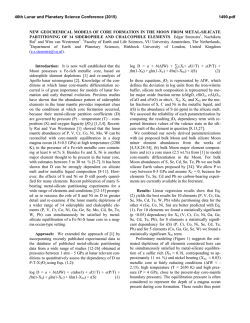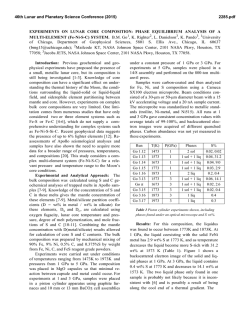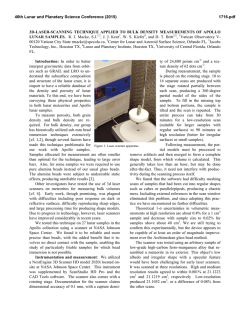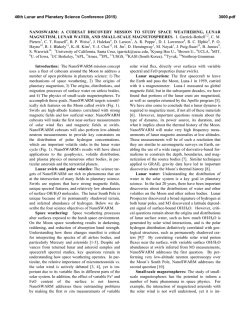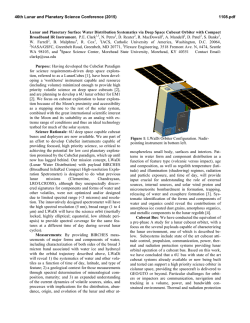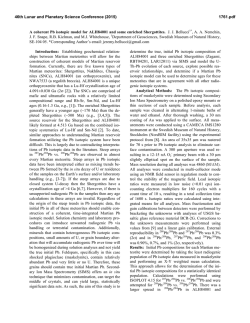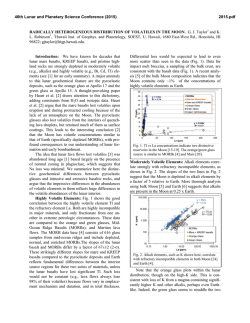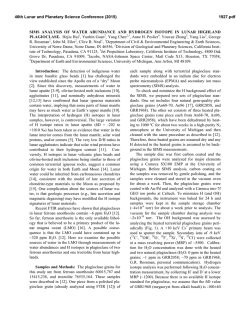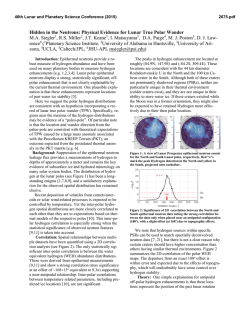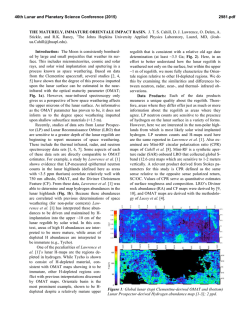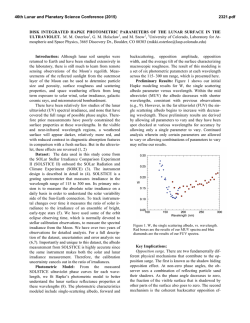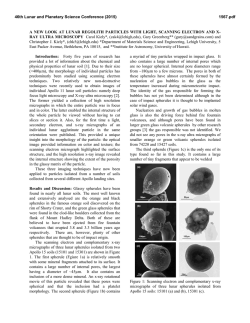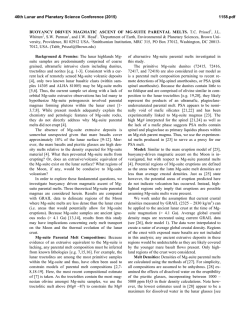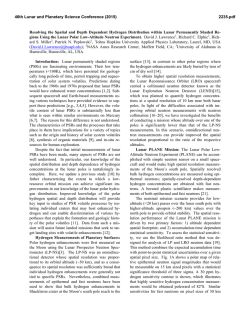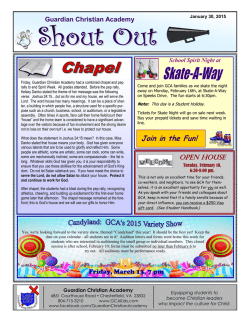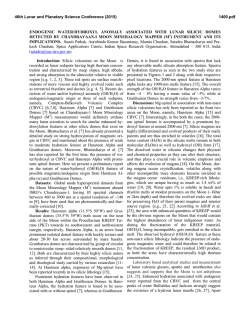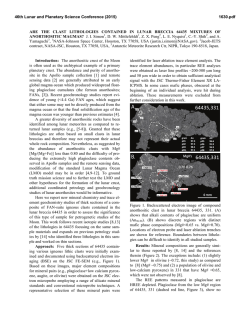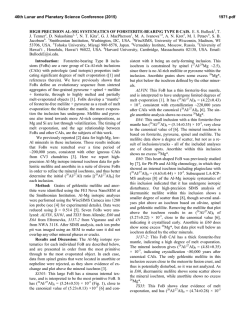
RUSTY ROCK
46th Lunar and Planetary Science Conference (2015) 1827.pdf THE “RUSTY ROCK” AND LUNAR PB. J. F. Snape1, A. A. Nemchin1,2, J. J. Bellucci1, and M. J. Whitehouse1, 1 Department of Geosciences, Swedish Museum of Natural History, SE-104 05 Stockholm, Sweden ([email protected]), 2Department of Applied Geology, Curtin University, Perth, WA 6845, Australia. Introduction: Initial studies of the Apollo 16 sample 66095 (or “Rusty Rock”) identified a number of unusual characteristics, the most obvious of which being the rust coloured stains on the surface and interior of the rock [1]. Multiple subsequent studies have focused on explaining the presence of this “rust” and the high volatile content of the rock (e.g. [2-6]). Another unique characteristic of 66095 is the high Pb content of the rock [2,7,8]. Despite being recognized in these early studies, the potential implications of this with regard to investigating the Pb isotopic composition of the Moon [7,9,10], have not received much recent attention. In situ Secondary Ion Mass Spectrometry (SIMS) analyses are capable of providing key information regarding the spatial distribution and isotopic composition of Pb in the sample. Sample description: We have investigated the UPb systematics of Ca-phosphates in a section of 66095 using SIMS. For most of the other lunar samples analysed to date, the amount of U within the Ca-phosphate phases varies between approximately 10-1000 µg/g. In the case of 66095, the Ca-phosphate U content varies between 0.04-94.8 µg/g. U-Pb dating relies on the inclusion of U and rejection of Pb in a mineral crystal lattice. This means that the majority of the Pb in the phases typically used for such analyses will be accumulated from the in situ decay of 235U, 238U and 232Th at a predictable rate. For example, most lunar samples analysed have low overall abundances of Pb, and this is typically very radiogenic Pb [10]. In the case of the Ca-phosphates in 66095, Pb appears to be unsupported by the decay of U and raises the prospect that the Pb isotopic composition in these phosphates may, in fact, provide a more direct indication of lunar Pb-isotopic reservoirs. Previous studies of other 66095 sections have identified a range of lithic clasts in the sample [11,12]. The section studied here, however, is composed almost exclusively of sub-ophitic impact melt comprised primarily of 10-50 µm sized grains of plagioclase and pyroxene. The element maps indicate the presence of several large (50-300 µm) Fe-rich grains. These are assumed to be similar to the FeNi metal reported by [2]. P-rich areas within these grains are likely schreibersite inclusions [2]. Also associated with the FeNi metal are numerous 10-50 µm sulfide phases (most likely troilite; [2]). An area of approximately 1 mm around the largest of the FeNi metal grains has the highest abundance of smaller metal grains and sulfides. These are more rare elsewhere in the sample. Methods: Backscattered electron (BSE) and element mapping of the sample was performed with a Quanta 650 FEGSEM. These maps were then used to identify Ca-phosphate phases for SIMS analysis. Prior to the SIMS analyses, the sample was thoroughly cleaned with distilled water and ethanol using an ultrasonic bath and was then gold coated. The U-Pb systematics of the grains were analysed with a CAMECA IMS 1280 ion microprobe at the NordSIMS facility in the Swedish Museum of Natural History, Stockholm, using a methodology similar to that outlined in previous studies [13]. The analyses were made with a primary beam current of approximately 1 nA and a spot size of 5 µm. A 15 µm area around each grain was presputtered for 120 seconds in order to remove the gold coating and minimize surface contamination. Sample data were calibrated against the BR2 2058 Ma apatite standard [14]. Results: The Ca-phosphate with the highest U concentration in the section (94.8 µg/g) was identified away from the large FeNi metal grain (Fig. 1). Nearer to the grain, the U concentrations in Ca-phosphate were much lower (0.04-4.18 µg/g) with a single grain identified with 19.5 µg/g. Similarly, the Th concentrations of phosphates were lowest (0.08-40.7 µg/g) close to the metal grain and higher (up to 215 µg/g) further away. The low U concentrations in the phosphates excludes the possibility of generating reliable a U-Pb age for the sample. However, a 207Pb/204Pb vs. 206Pb/204Pb isochron age of 3646±260 Ma (2σ) was calculated for the 66095 phosphates. Discussion: Recent analyses of 66095 [6] suggest that the volatile enrichments in the sample are likely the results of volatile species being mobilised, possibly during the degassing of an ejecta blanket. This led to the deposition of metals (e.g. Zn, Cu, Pb and Fe) in the rock from a “metal-chloride-bearing and H-poor gas phase”. As such, it is reasonable to assume that the Pb in 66095 does indeed represent an indigenous lunar Pb component. The new isochron age calculated for the phosphates is within error of two previous estimates for the age of 66095. These include a Pb isochron age of 3820 Ma [7] and a “maximum” Ar plateau age of 3790±50 Ma [15]. The previous Pb isochron age was calculated using old decay constants and analytical uncertainties were not provided [7], making it impossible to re- 46th Lunar and Planetary Science Conference (2015) calculate the age with more recent decay constants. The Ar plateau age is not well defined and likely complicated by the presence of older relict clasts in the rock. The range of Pb isotopic compositions in the data are interpreted as representing mixing between an initial Pb component (the points with the highest 207 Pb/206Pb ratios) and radiogenic Pb produced by in situ decay of U (intercept of the 66095 isochron and the vertical axis in Fig. 1). The very radiogenic composition of the initial Pb places some limitations on the origin of reservoir where this Pb has been accumulated, even though identification of the nature of this reservoir is inhibited by the lack of precise determination of the 66095 breccia formation time. If the Pb is assumed to have developed from a starting composition similar to Canyon Diablo Troilite (CDT; [16]), and age of the sample (T1 in Fig. 1) is assumed to be close to that determined from the Pb-Pb isochron (i.e. ~3.65 Ga), then the source of the Pb would need to have formed (T0 in Fig. 1) close to the time of formation of the Solar System, i.e. too old taking into account that the Moon formed at least ~60 Ma after the condensation of the first solids in the Solar System [17]. This model can be represented in the 207Pb/206Pb vs. 204 Pb/206Pb coordinate space (Fig. 1). Here the intercept between the 66095 isochron and the isochrons originating from CDT values define the composition of the initial Pb when it was incorporated into the sample (n.b. this assumes that evolution of the Pb isotope composition from CDT values was limited between the formation of the Solar System and T0). As such, this intercept must occur at or above the 66095 values with the highest 207Pb/206Pb ratios (Fig. 1a). 1827.pdf If the age of the sample is assumed to be ~3.8 Ga, close to that defined from the existing Ar-Ar and previous Pb-Pb data, the time of lunar radiogenic Pb reservoir formation is defined to be close to 4.5 Ga, i.e the proposed time of the Moon formation. In this case, the radiogenic Pb would reflect the bulk silicate Moon composition (µ ~ 650; where µ is the ratio of 238 U/204Pb; Fig. 1a). Finally, if the upper limit of the age range for the breccia sample (~3.9 Ga), which is also considered to be the time of intense meteorite bombardment of the Moon, is taken as the age of the sample, the time of reservoir formation is calculated close to ~4.4 Ga. This is close to the timing of the final stages of LMO crystallisation. If that is the case, the most radiogenic Pb measured would reflect the composition of lunar crust (µ ~ 950; Fig. 1b). References: [1] LSPET (1973) Science, 179, 23– 34. [2] El Goresy A. et al. (1973) EPSL, 18, 411-419. [3] Taylor L. A. et al. (1974) Geology, 2, 429-432. [4] Epstein S. and Taylor H. P. (1974) LPS V, 1839-1854. [5] Allen R. O. et al. (1975) LPS XI, 2271-2279. [6] Shearer C. K. et al. (2014) GCA, 139, 411-433. [7] Nunes P. D. and Tatsumoto M. (1973) Science, 182, 916-920. [8] Hinthorne J. R. and Andersen C. A. (1974) LPS V, 337-339. [9] Tatsumoto M. (1987) LPS XVII, 361-371. [10] Nemchin A. A. et al. (2011) GCA, 75, 2940-2964. [11] Garrison J. R. and Taylor L. A. (1980) GCA, Supp. 12, 395-417. [12] Hunter R. H. and Taylor L. A. (1981) LPS XII, 261-280. [13] Nemchin A. A. (2009) MAPS, 44, 1717-1734. [14] Grange et al. (2009) GCA, 73, 3093-3107. [15] Turner G. et al. (1973) LPS IV, 1889-1914. [16] Göpel C. et al. (1985) GCA, 49, 1681-1695. [17] Touboul M. et al. (2007) Nature, 450, 1206-1209. Figure 1. Pb-isotopic compositions of the phosphates in 66095 plotted in the 207Pb/206Pb vs. 204Pb/206Pb coordinate space.
© Copyright 2025
